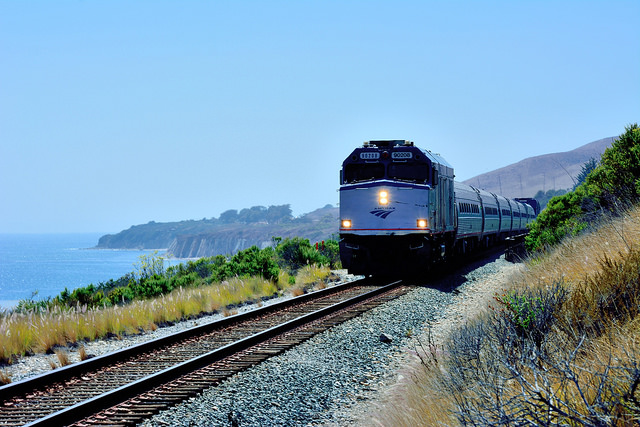The purpose of this post is to share my experiences using Amtrak to travel, with a focus on the accessibility of Amtrak’s fleet. I have a C5 ASIA B spinal cord injury, use a Permobil C500 for mobility, and stay in my wheelchair (i.e. do not transfer) when I travel. I travel on Amtrak four to six days a year—typically day trips on the Northeast Corridor between Trenton, NJ and Washington, DC. I have traveled on three types of Amtrak train cars: Acela business class, Amfleet coach class, and the Viewliner in its accessible bedroom. My descriptions include most Amtrak passenger cars able to accommodate wheelchairs (the main exception being the Superliner sleeper car with an accessible bedroom).
Before I discuss the accessibility of the trains, let me briefly describe how passengers in wheelchairs board the train. On the Northeast Corridor, most (if not all) stations have elevated platforms. When on an elevated platform, able bodied people do not need to climb steps to enter the train—the just need to step over the gap between the platform and the train. To bridge the gap between the platform and the train for wheelchair passengers, conductors lay down a bridge plate, which is essentially a small ramp designed especially for this task. Most Amtrak stations throughout the country, however, do not have elevated platforms. Rather, most stations trains let able bodied passengers out by having them climb down stairs and exit at the track level. Stations with standard platforms have manual lifts that elevate wheelchairs passengers up to a level at which the passengers can roll onto the train. The lifts are clunky but get the job done and appear to be pretty reliable.
Design after the ADA and entering service in 2000, the Acela is the most accessible (and expensive) train on the Northeast Corridor. The door to board the train, the restrooms, and the hallways to the wheelchair space are all accessible by ADA standards. I was even able to go from my car to the café car while the train was in motion. On Amtrak’s other trains, I cannot move across cars, even when the train is not in motion. The wheelchair space also has a multipurpose table. My only complaint is that the wheelchair space could be a little bigger and getting in it is somewhat awkward. Acela trains always board from elevated platforms.
The Amfleet cars, which look like aluminum cans and comprise the vast majority of Amtrak’s passenger car fleet, are 35 to 40 years old and fairly inaccessible. The hallway from the exterior door to the main compartment and wheelchair space is narrow and includes a sharp, 90 degree turn. The turn is so sharp that I must take my backpack off to make the turn. I often struggle with the turn (and I have been using a Permobil for 18 years.) The wheelchair space in the main compartment is large, except when you are sharing it with luggage. There are two bathrooms by the wheelchair space, and one is designated as “accessible.” The accessible bathroom is very small—my wheelchair can fit inside, but once inside I cannot move the wheelchair at all. I cannot use the Amfleet accessible restroom independently.
The Viewliner is a sleeper car that is only on long distance routes that operate on part of the Northeast Corridor, where clearance is too low for the larger Superliner sleeper cars. Each Viewliner has one accessible bedroom with two beds, two sets, and a private bathroom. The hallways from the exterior door to the accessible bedroom are wide, and I made turns easily. There’s not much room to maneuver in the bedroom, but overall it’s a decent space. Though I could not enter the dining car.
In summary, accessibility on Amtrak is mixed. Whatever train you are on, you can stay in your wheelchair, so you avoid the potential for damage caused by checking your wheelchair with your luggage like with an airline. However, the most accessible train travel options are the most expensive and the Amfleet cars are not really accessible.
Have a question about living with a disability? Ask a Peer in the comments below.
For more information on Magee’s Peer Mentor Program, click here.
Guest Author: David Mann, Magee Peer Mentor





